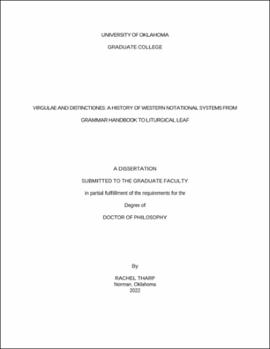| dc.contributor.advisor | Ransom, Daniel | |
| dc.contributor.author | Tharp, Rachel | |
| dc.date.accessioned | 2022-05-04T20:35:54Z | |
| dc.date.available | 2022-05-04T20:35:54Z | |
| dc.date.issued | 2022-05-13 | |
| dc.identifier.uri | https://hdl.handle.net/11244/335512 | |
| dc.description.abstract | I present the history of the virgule or slash (/) as a measure of how students read and interpreted texts first by methods taught in grammar handbooks but then according to scribal-driven innovations to the page. The mark primarily operates in four ways: as an outsider to distinctiones, the dominant mode of punctuating from the first century CE to the ninth; as the term virgula, a “stem” or “twig” describing the shapes of accents or critical signs in grammatical treatises; as a runover or punctuation mark, both byproducts of Insular innovations in book production during the eighth and ninth centuries; and as an outsider yet again in Carolingian scriptoria, where scribes preferred a modified version of distinctiones or a new system of liturgical punctuation called positurae. The history of the virgule reveals how the responsibilities once considered as acts of interpretation left to the reader became expectations for the appearance of texts placed upon the scribe. | en_US |
| dc.language | en_US | en_US |
| dc.subject | punctuation | en_US |
| dc.subject | manuscript studies | en_US |
| dc.subject | Latin grammar | en_US |
| dc.subject | Middle Ages | en_US |
| dc.title | Virgulae and Distinctiones: A History of Western Notational Systems from Grammar Handbook to Liturgical Leaf | en_US |
| dc.contributor.committeeMember | Mansky, Joseph | |
| dc.contributor.committeeMember | Endres, William | |
| dc.contributor.committeeMember | Huskey, Samuel | |
| dc.contributor.committeeMember | Coleman, Joyce | |
| dc.date.manuscript | 2022-05-03 | |
| dc.thesis.degree | Ph.D. | en_US |
| ou.group | Dodge Family College of Arts and Sciences::Department of English | en_US |
| shareok.orcid | 0000-0002-0062-5110 | en_US |
| shareok.nativefileaccess | restricted | en_US |
